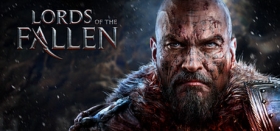
E3 2014 - Lords of the Fallen Preview
If at first glance Lords of the Fallen reminds you of Dark Souls, you wouldn’t be too far off the mark; developer CI Games freely admits that From Software’s critically acclaimed series was an inspiration. Lords of the Fallen features the same approach to combat—relentlessly punishing—and has visuals to match. Add the game’s heavy dark fantasy influences on world-building and character design, and it’s pretty apparent CI is looking to appeal to the same fans who love the masochistic gameplay of Dark Souls.
While Lords of the Fallen isn’t likely to break any moulds that Dark Souls hasn’t (a series that is without a doubt a tough act to follow), it manages to shine through in terms of its plot and mythology, which successfully takes it out from Dark Souls’ shadow—if only for a brief proverbial moment.
The game is set in a world where thousands of years ago, humans banded together to fight a war with an evil god, eventually defeating him. In a last act of defiance, the god shoved his hand through the land’s surface, creating a range of finger-like mountains called the God’s Hand Mountains. After their victory, humanity turned its focus to ridding the world of sin and the last traces of evil. In the Lords of the Fallen universe, those who commit crimes are branded and outcast from society, never to be forgiven. However, the evil god and his demonic armies have returned, and this time to a humanity entirely unprepared to fight him off. So how do you handle this if you’re a lord? You send for the worst criminal you can find, our main character Harkyn, and get him to do your fighting for you.

Well, consider my interest piqued for the moment. Harkyn is a bruiser type who looks like he’d be at home on the set of Vikings; definitely not the sort of person you’d want to meet walking alone at night. Lords of the Fallen also features a rather interesting spin on the traditional class system: players pick a class from the standard cleric, rogue or warrior, which affects their magical abilities, but not their stats and gear. While the game clearly labels armor and weapons for a specific class—for example the demo I played had a “rogue’s dagger” and “cleric’s staff”—these are more suggestions than anything else, which players can ignore in favour of mixing and matching.
Combat, I quickly discover, is definitely not something that I’m finding very easy in this game. But then again, neither apparently is interviewing while trying to play; so really the Lords of the Fallen demo is all about showing off my weaknesses. Fighting is quick-paced, and while the game makes use of hack and slash combat, it’s not the sort of game that can be beaten by button mashing. After moving out of a hallway where I fight three monsters called the Infected, I end up in a cramped open air courtyard. Another feature that seems to distinguish Lords of the Fallen is its wider colour palette and freer use of light.

After more combat—which is both brief and brutal—and the unfortunate discovery that health does not recharge as per usual, I take on my first mini-boss, an enemy with a huge shield which he uses to bowl Harkyn over any chance he gets. After letting me get mauled once, the developer I’ve been talking to points out a conspicuous set of planks over a gaping hole in the courtyard. I actually have the option to lure the enemy over them, letting the boards break under it and causing the creature to fall to its death. While I won’t get any loot or experience this way, it saves me from having to face the enemy directly.
Reloading and reclaiming my lost experience points (which are stored at your point of death and decay over time until you collect them á la Dark Souls), I opt for brains over brawn and let the enemy fall. Worth noting, however, is the fact that if his armour had been heavy enough Harkyn would have been the one to break the boards. The game cuts both ways, it seems. Despite its violent air, Lords of the Fallen seems to follow the idiom that discretion is the better part of valour when it comes to combat. Open battle is risky, and your enemies seem to have about a 50% chance of reviving right after defeat.
The game’s map is open-world, although not a complete sandbox map, and players visit different locations to progress the story and complete side missions which they reach via a central temple that acts as a home base. While Dark Souls was always light-handed with its storytelling, Lords of the Fallen puts its story at centre stage. There’s never exactly a point where the credits roll, but the game does have a clear start and end, with the chance for players to go back and revisit locations or complete side missions.

Lords of the Fallen’s greatest risk is probably the potential for gamers to write it off as a Dark Souls rip-off. The parallels are clear, but Lords of the Fallen owes little more to the series than its role in establishing a new subgenre. CI’s game has an identity of its own, and a promising one at that. It also has the potential to serve as a litmus test to see if Dark Souls will forever be unique in its success and critical acclaim. Although I can’t say I’ll probably pick up Lords of the Fallen in the future, that’s more due to personal preference than any fault of CI Games; this sort of game has just never really been my cup of tea to begin with.
Lords of the Fallen comes out for new-gen consoles sometime at the end of this year, although there’s no official release date yet.










COMMENTS